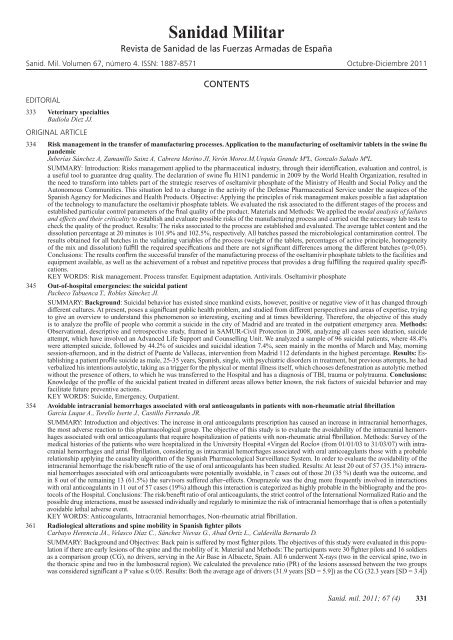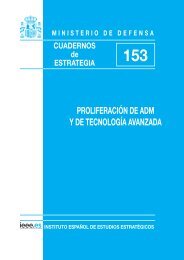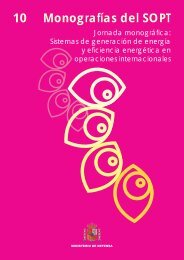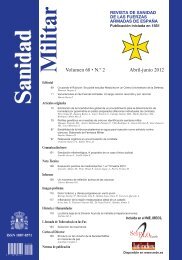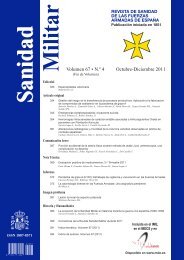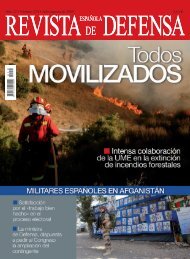Sanidad Militar - Portal de Cultura de Defensa - Ministerio de Defensa
Sanidad Militar - Portal de Cultura de Defensa - Ministerio de Defensa
Sanidad Militar - Portal de Cultura de Defensa - Ministerio de Defensa
Create successful ePaper yourself
Turn your PDF publications into a flip-book with our unique Google optimized e-Paper software.
<strong>Sanidad</strong> <strong>Militar</strong><br />
Revista <strong>de</strong> <strong>Sanidad</strong> <strong>de</strong> las Fuerzas Armadas <strong>de</strong> España<br />
Sanid. Mil. Volumen 67, número 4. ISSN: 1887-8571 Octubre-Diciembre 2011<br />
EDITORIAL<br />
333 Veterinary specialties<br />
Badiola Díez JJ.<br />
ORIGINAL ARTICLE<br />
CONTENTS<br />
334 Risk management in the transfer of manufacturing processes. Application to the manufacturing of oseltamivir tablets in the swine flu<br />
pan<strong>de</strong>mic<br />
Juberías Sánchez A, Zamanillo Sainz A, Cabrera Merino JI, Verón Moros.M,Urquía Gran<strong>de</strong> MªL, Gonzalo Salado MªL.<br />
SUMMARY: Introduction: Risks management applied to the pharmaceutical industry, through their i<strong>de</strong>ntification, evaluation and control, is<br />
a useful tool to guarantee drug quality. The <strong>de</strong>claration of swine flu H1N1 pan<strong>de</strong>mic in 2009 by the World Health Organization, resulted in<br />
the need to transform into tablets part of the strategic reserves of oseltamivir phosphate of the Ministry of Health and Social Policy and the<br />
Autonomous Communities. This situation led to a change in the activity of the Defense Pharmaceutical Service un<strong>de</strong>r the auspices of the<br />
Spanish Agency for Medicines and Health Products. Objective: Applying the principles of risk management makes possible a fast adaptation<br />
of the technology to manufacture the oseltamivir phosphate tablets. We evaluated the risk associated to the different stages of the process and<br />
established particular control parameters of the final quality of the product. Materials and Methods: We applied the modal analysis of failures<br />
and effects and their criticality to establish and evaluate possible risks of the manufacturing process and carried out the necessary lab tests to<br />
check the quality of the product. Results: The risks associated to the process are established and evaluated. The average tablet content and the<br />
dissolution percentage at 20 minutes is 101.9% and 102.5%, respectively. All batches passed the microbiological contamination control. The<br />
results obtained for all batches in the validating variables of the process (weight of the tablets, percentages of active principle, homogeneity<br />
of the mix and dissolution) fulfill the required specifications and there are not significant differences among the different batches (p>0,05).<br />
Conclusions: The results confirm the successful transfer of the manufacturing process of the oseltamivir phosphate tablets to the facilities and<br />
equipment available, as well as the achievement of a robust and repetitive process that provi<strong>de</strong>s a drug fulfilling the required quality specifications.<br />
KEY WORDS: Risk management. Process transfer. Equipment adaptation. Antivirals. Oseltamivir phosphate<br />
345 Out-of-hospital emergencies: the suicidal patient<br />
Pacheco Tabuenca T., Robles Sánchez JI.<br />
SUMMARY: Background: Suicidal behavior has existed since mankind exists, however, positive or negative view of it has changed through<br />
different cultures. At present, poses a significant public health problem, and studied from different perspectives and areas of expertise, trying<br />
to give an overview to un<strong>de</strong>rstand this phenomenon so interesting, exciting and at times bewil<strong>de</strong>ring. Therefore, the objective of this study<br />
is to analyze the profile of people who commit a suici<strong>de</strong> in the city of Madrid and are treated in the outpatient emergency area. Methods:<br />
Observational, <strong>de</strong>scriptive and retrospective study, framed in SAMUR-Civil Protection in 2008, analyzing all cases seen i<strong>de</strong>ation, suici<strong>de</strong><br />
attempt, which have involved an Advanced Life Support and Counselling Unit. We analyzed a sample of 96 suicidal patients, where 48.4%<br />
were attempted suici<strong>de</strong>, followed by 44.2% of suici<strong>de</strong>s and suicidal i<strong>de</strong>ation 7.4%, seen mainly in the months of March and May, morning<br />
session-afternoon, and in the district of Puente <strong>de</strong> Vallecas, intervention from Madrid 112 <strong>de</strong>fendants in the highest percentage. Results: Establishing<br />
a patient profile suici<strong>de</strong> as male, 25-35 years, Spanish, single, with psychiatric disor<strong>de</strong>rs in treatment, but previous attempts, he had<br />
verbalized his intentions autolytic, taking as a trigger for the physical or mental illness itself, which chooses <strong>de</strong>fenestration as autolytic method<br />
without the presence of others, to which he was transferred to the Hospital and has a diagnosis of TBI, trauma or polytrauma. Conclusions:<br />
Knowledge of the profile of the suicidal patient treated in different areas allows better known, the risk factors of suicidal behavior and may<br />
facilitate future preventive actions.<br />
KEY WORDS: Suici<strong>de</strong>, Emergency, Outpatient.<br />
354 Avoidable intracranial hemorrhages associated with oral anticoagulants in patients with non-rheumatic atrial fibrillation<br />
García Luque A., Torello Iserte J., Castillo Ferrando JR.<br />
SUMMARY: Introduction and objectives: The increase in oral anticoagulants prescription has caused an increase in intracranial hemorrhages,<br />
the most adverse reaction to this pharmacological group. The objective of this study is to evaluate the avoidability of the intracranial hemorrhages<br />
associated with oral anticoagulants that require hospitalization of patients with non-rheumatic atrial fibrillation. Methods: Survey of the<br />
medical histories of the patients who were hospitalized in the University Hospital «Virgen <strong>de</strong>l Rocío» (from 01/01/03 to 31/03/07) with intracranial<br />
hemorrhages and atrial fibrillation, consi<strong>de</strong>ring as intracranial hemorrhages associated with oral anticoagulants those with a probable<br />
relationship applying the causality algorithm of the Spanish Pharmacological Surveillance System. In or<strong>de</strong>r to evaluate the avoidability of the<br />
intracranial hemorrhage the risk/benefit ratio of the use of oral anticoagulants has been studied. Results: At least 20 out of 57 (35.1%) intracranial<br />
hemorrhages associated with oral anticoagulants were potentially avoidable, in 7 cases out of those 20 (35 %) <strong>de</strong>ath was the outcome, and<br />
in 8 out of the remaining 13 (61.5%) the survivors suffered after–effects. Omeprazole was the drug more frequently involved in interactions<br />
with oral anticoagulants in 11 out of 57 cases (19%) although this interaction is categorized as highly probable in the bibliography and the protocols<br />
of the Hospital. Conclusions: The risk/benefit ratio of oral anticoagulants, the strict control of the International Normalized Ratio and the<br />
possible drug interactions, must be assessed individually and regularly to minimize the risk of intracranial hemorrhage that is often a potentially<br />
avoidable lethal adverse event.<br />
KEY WORDS: Anticoagulants, Intracranial hemorrhages, Non-rheumatic atrial fibrillation.<br />
361 Radiological alterations and spine mobility in Spanish fighter pilots<br />
Carbayo Herencia JA., Velasco Díaz C., Sánchez Nievas G., Abad Ortiz L., Cal<strong>de</strong>villa Bernardo D.<br />
SUMMARY: Background and Objectives: Back pain is suffered by most fighter pilots. The objectives of this study were evaluated in this population<br />
if there are early lesions of the spine and the mobility of it. Material and Methods: The participants were 30 fighter pilots and 16 soldiers<br />
as a comparison group (CG), no drivers, serving in the Air Base in Albacete, Spain. All 6 un<strong>de</strong>rwent X-rays (two in the cervical spine, two in<br />
the thoracic spine and two in the lumbosacral region). We calculated the prevalence ratio (PR) of the lesions assessed between the two groups<br />
was consi<strong>de</strong>red significant a P value ≤ 0.05. Results: Both the average age of drivers (31.9 years [SD = 5.9]) as the CG (32.3 years [SD = 3.4])<br />
Sanid. mil. 2011; 67 (4) 331


